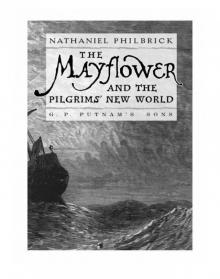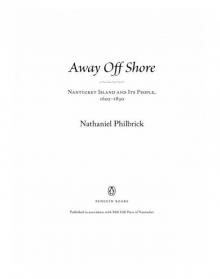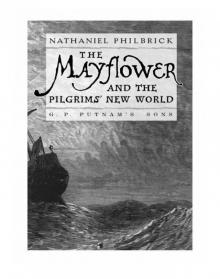- Home
- Nathaniel Philbrick
Away Off Shore: Nantucket Island and Its People, 1602-1890 Page 3
Away Off Shore: Nantucket Island and Its People, 1602-1890 Read online
Page 3
But as Nantucket grew, its expenditures for capital improvements did not keep pace. Even though their wharves were piled high with casks of the world’s best illuminant, the tight-fisted townspeople resolutely refused to light their own streets. According to the local paper, “When oil will not sell, the people cannot afford to light the streets; and when it will sell, it cannot be expected that they who have it will illumine the common pathway of the community.” As a result, walking the streets of town on a foggy summer night was an extremely hazardous undertaking as more than a few Nantucketers bumped into parked calashes or fell into open cesspools.
Without a municipal sewer system, this highly concentrated urban center of 10,000 people (very close to Nantucket’s current year-round population) suffered from the stench of more than just whale oil as the mucky swamp that had once been Lily Pond degenerated into an open sewer. The town’s growth also threatened its squeaky clean moral reputation. According to an account published in 1846, sailors frequented a section known as “Nantucket hill” (which seems to have been in the vicinity of today’s Cliff Road), where “vice knows no bounds, and crime has no stopping place, . . . the days and nights being spent in drunkenness and debauchery.” Before a rabid temperance movement began to take hold in the 1830s and ’40s, no less than sixty grog shops existed between New North and Commercial wharves.
But Nantucket’s prosperity—both ill-gotten and whalegotten—was not to last. On one terrible night in 1846 fire destroyed more than one-third of the town. Today, all that survives of Nantucket’s original waterfront is a partly submerged pile of rubble off the stunted remnants of Old North Wharf. While the many historic homes on the island are fascinating in their own right, they do little to evoke a sense of Nantucket as the tremendously active (and fairly seedy) commercial center it once was.
Nantucket’s fall as a whaling port was only partly a result of the Great Fire of 1846. Even though they had found a way to pay for the food and lumber they could no longer grow on the island, Nantucketers were ultimately unable to overcome yet another challenge presented by their environment: the sandy shoals that surrounded them. As early as 1760, the itinerant Quaker preacher John Woolman remarked on the “great shoal, which encloses their harbor [and] prevents them going in with sloops, except when the tide is up; waiting without which, for the rising of the tide, is sometimes hazardous in storms; waiting within, they sometimes miss a fair wind.” Extensive clay deposits under the sand meant that the Nantucket Bar was not about to wash away. Even if there had never been a fire, the inaccessibility of the town’s harbor to deep-draft ships had sealed (quite literally) Nantucket’s fate as a whaling has-been.
During the second half of the nineteenth century, the sheep gradually disappeared and Captain Gardner’s pitch pines began to spread across the island as Nantucket evolved into the scrubby, tree-dotted summer community it is today. In 1851 two leading whaling merchants, Charles and Henry Coffin, planted the first elm trees on Main Street. In 1875 one visitor commented on the “scraggly, weird-looking pitch-pines that are slowly replacing” the once unencumbered vistas. Today, a century after the end of island-wide sheep grazing on Nantucket, a program of brushcutting and controlled burning has been instituted in an effort to preserve the remaining heathlands.
Just as it had helped lure the Indians centuries before, Nantucket’s climate played a key role in bringing tourists to the island at the end of the nineteenth century. But instead of the mildness of the winters, it was the cool sea breezes of summer that attracted the city-dweller to Nantucket. There were, however, some major impediments to the establishment of a tourist industry. The town’s sanitation problems could no longer be ignored. A report written in 1891 commented on “the dumping place where we invite our visitors to land from steamers where fish offal, slaughterhouse filth, and decayed fruit are deposited in quantities, filling the air with foul gasses.” What is now known as Easy Street (and the site of a much-heralded scenic view) was then simply called “The Dump.” Gradually and inevitably, Nantucket began to clean itself up until it is now, some would say, an overly tidy restoration of the nineteenth-century whaling port it once was.
Although two jetties now keep a channel open across the Nantucket Bar, there are bigger problems facing the island. Dramatic beach erosion, particularly on the southeastern side of Nantucket, continues to whittle away at its sandy shores. It is estimated that the rising sea levels that created the island 5,000 years ago will ultimately lead to its demise in a fraction of that time. Some estimates put it at 2,000 years; others say that in as few as 400 years waves will be lapping over Altar Rock, the boulder that the glacier deposited high atop what was then a sandy hill.
If Nantucket is destined to become another Atlantis, we can only hope that its inhabitants will not be forgotten. With this in mind, let us now turn to the island’s first people, the Indians.
CHAPTER 2
Native Origins: Maushop, Roqua, Wonoma, and Autopscot
INSTEAD OF A GLACIER, the Indians credited Nantucket’s formation to Maushop, the Native American forefather of Paul Bunyan. According to legend, Maushop was so big that the only place he could comfortably sleep was along the southern shore of Cape Cod. Unfortunately, he did not like getting sand in his moccasins—a difficult thing to avoid when your bed is a beach. One night, after many hours of tossing and turning, Maushop finally kicked off one of his moccasins in exasperation. It only went a short way and became Martha’s Vineyard. Growing increasingly restless and annoyed with the sand in his other moccasin, he kicked it even farther. It became known as Nantucket, meaning “the faraway land.”
Although there is archeological evidence that Native Americans had been coming to Nantucket when it was still an inland hillside, the myths that have been passed down to us come from a culture that knew it only as an island. These were the Wampanoag (often referred to as the Pokanokets in the seventeenth century), a subset of the Algonquians who settled throughout southern New England. It was the Wampanoag who greeted the Pilgrims at Plymouth, and their sachem (or leader) Massasoit seems to have had jurisdiction over Indians throughout Cape Cod and the islands.
There were two distinct groups of Wampanoag on Nantucket. Those on the eastern end of the island originally came from Cape Cod and brought with them the legend of Maushop’s moccasin. The Indians to the west, however, came from Martha’s Vineyard and, as might be expected, had a different view of Nantucket’s origin. According to these Indians, Maushop originally lived on the Vineyard, known then as Noepe, where he spent his time feasting on whales and smoking his pipe while his people prospered. Then one day a young couple, Nanina and Waposset, came to him with a problem. Nanina’s father refused to let her marry Waposset because of his humble birth. Maushop, who had always favored Waposset, told them to fetch Nanina’s father and meet him at the eastern end of the island. Soon everyone was assembled, and in truly glacier-like fashion Maushop began to dig a deep hole into the sea, which he then filled up with many stones. After lighting his giant pipe with a thunderbolt, he knocked out the ashes into the sea, causing a great hissing cloud of steam to rise up into the air. Eventually the fog cleared and a new island appeared before them. This, Maushop declared, was to be Nanina and Waposset’s home. With his future son-in-law’s new real estate holdings more than compensating for what he lacked in social standing, Nanina’s father readily agreed to the marriage. It is this legend of the island’s spectacular birth that has led certain jealous parties from the Vineyard to refer to Nantucket as the “Devil’s Ash Heap.”
There is a third legend about Maushop and Nantucket that may give us some indication as to why these two groups of Indians originally came to Nantucket. According to this story, there was once a huge bird that would swoop down over the villages of Cape Cod, grab a child in its talons, and fly off across the sea. Finally the mothers banded together to ask Maushop to find out where the bird was taking their children. Always willing to help, Maushop waded far out into the sea until he sighted a
n island he had never seen before. After a thorough investigation, he found a pile of small whitened bones beneath a tree. His search now ended, Maushop sat down for a contemplative smoke and soon the island was blanketed by a thick gray cloud. For years to come Nantucket’s Native Americans would greet the appearance of fog by saying, “Here comes old Maushop’s smoke.”
By linking the island’s discovery with sudden and inexplicable death, this legend may point to how the European-spawned plagues that decimated New England’s Native Americans from 1616 to 1619 contributed to the growth of Nantucket’s Indian population. While huge numbers of Indians died up and down the coast (more than half the total population, according to some estimates), Nantucket appears to have been left relatively untouched by disease in the first half of the seventeenth century. The many shoals surrounding the island discouraged sailors from approaching Nantucket, thus minimizing early English-Indian contact. Testifying to the dangers of these shoals were the names left by the crew of Bartholomew Gosnold’s ship in 1602: “Tucker’s Terror” and “Point Care.” In fact, if it had not been for the shoals off Monomoy that caused them to double back in panic around Cape Cod in 1620, the Pilgrims might very well have first stepped on Wesco instead of Plymouth Rock.
As increasing numbers of white settlers arrived in New England, the shoal-guarded remoteness of Maushop’s sandy moccasin or ash heap, depending on your point of view, may have become increasingly attractive to Indians on the Cape and Martha’s Vineyard. Indeed, as the Native American population dramatically shrank throughout the rest of the region, Nantucket’s Indian population seems to have, if anything, increased. It is estimated that by the middle of the seventeenth century there were as many as 3,000 Indians on Nantucket (equivalent to almost a third of the island’s current year-round population). This would have meant that the island possessed an Indian population that was more than ten times what the concentration on the mainland had been before the plagues, placing tremendous demands on Nantucket’s natural resources. No wonder there were no deer left on the island.
According to tradition, the eastern and western Indians developed noticeably different cultures, partly as a result of the different natural features and wildlife the two portions of the island had to offer. The western group, known as the Taumkhods, relied primarily on shellfishing and driftwhaling (even today dead whales most commonly wash up along the southwestern shore of the island), while the eastern Indians, known as the Khauds (which may have referred to the codfish that frequent the shoals off Siasconset), were bird hunters and fishermen, using tree bark to fashion fishing lines.
Tradition has it that the Indian depicted on the Massachusetts Bay seal of 1629 was based on a Khaud sachem who was taken to England. The seal depicts a slender yet muscular darkskinned man with long black hair tied behind; except for a cluster of leaves around his mid-section, he is naked; in his right hand is a feather; in his left is a bow. As far as clothing, James Freeman reported in 1807 that prior to the arrival of the English the Indians wore “sometimes skins, but for the most part coarse mats, made of grass.” He also claimed that Nantucket Indians knew how to roast but did not know how to boil their food. Unlike those on the mainland, Nantucket Indians did not manufacture wampum. According to Crèvecoeur, “The only ancient custom of these people that is remembered is that in their mutual exchanges, forty sun-dried clams, strung on a string, passed for the value of what might be called a copper.” While most Native Americans in New England smoked tobacco, those on Nantucket smoked pokeweed in “stone” pipes made from the rich clay deposits along the north shore of the island. In the swamps near Siasconset in the eastern end of the island grew groundnuts, a white, potatolike tuber that the Indians relied upon for food.
For shelter, they built wigwams: low, rounded dwellings made from bent saplings covered with mats to keep the weather out. These structures were easily taken down and rebuilt as the Indians moved throughout their territories to take advantage of seasonal changes, a process that Obed Macy attributed to “a restless disposition inherent in their nature.” In winter, a central fire kept the wigwams surprisingly warm, “albeit very smoky,” according to a contemporary account, with only an opening in the roof serving as a chimney.
Nantucket Indians also built “sweat houses,” temporary, cave-like structures dug into shore-side hills, that functioned much in the same way as the modern-day sauna. In 1724 Paul Dudley gave this description of such a house, provided to him by “a gentleman of the island of Nantucket where the Indians sometimes practice it even at this day”:Near the cave they make a good large fire, and heat a parcel of stones . . . and roll them in hot, piling them up in the middle of it; when this is done, the Indians go in naked, and sit-round the heated stones; as soon as they begin to grow faint, which may be in a quarter of an hour, they come out and plunge themselves all over in the water for a minute or two. . . . The Indians often used it before and after long journeys, hunting, or voyages to strengthen and refresh themselves.
While the men sweated, hunted, and fished, the Indian women shouldered the brunt of the day-to-day labor of village life—tending crops, grinding corn, cooking meals, weaving baskets and reed mats, making clay pottery—not to mention raising the children. Indeed, even the English, who were far from being feminists, remarked on the lopsided division of labor among the Indians throughout New England: “[The men] bestow their times in fishing, hunting, wars and such man-like exercises, without the doors, scorning to be seen in any effeminate labor, which is the cause that women be very painful.”
Before we begin to think that the Indian men had it easy, we must realize that hunting, fishing, and fighting were not idle amusements in Native American culture; they were, quite literally, matters of life and death, requiring great skill and endurance. When a state of war existed between the two factions on the island, surveillance and communication were vital to avoiding surprise attack. A single Indian runner was capable of covering as many as 100 miles a day (roughly equivalent to two circumnavigations of the island), demonstrating that even before the horse, car, and telephone, news traveled fast on Nantucket.
If the legends that have been passed down to us are any indication, the early seventeenth century was a time of bitter fighting between the Khauds and Taumkhods—their territorial rivalries exacerbated, no doubt, by competition for food on this overcrowded island. One legend tells of a titanic battle in Madequecham (pronounced “MAD-a-ka-sham”) Valley, a glacier-induced crease across the center of the island that also provided a boundary between the two factions. Another legend tells of several massacres in Madaket on the western end of the island. But it is the story of Roqua that provides the best example of just how claustrophobically brutal life could be when there were two warring peoples on an island only fourteen miles in length.
The son of an old Khaud sachem on the eastern end of the island, Roqua lived with his father, wife, and daughter in their village near what is today the cranberry bogs. At one point, war broke out between the Khauds and the Taumkhods. Although Roqua led his men heroically in battle, it was a lost cause. By the time the fighting had ended, Roqua was one of the few easterners left alive. Meanwhile, as this terrible struggle was reaching its conclusion in Madequecham Valley, yet another party of Taumkhods launched an attack on Roqua’s undefended village. When the defeated eastern warriors returned home, they found ruins.
The wigwams were ashes; the bodies of his people—including his father, wife, and daughter—lay scattered amid the embers. After binding his wounds, Roqua spent most of the day burying the bodies of his loved ones. Then, with a war club in one hand and a spear in the other, he waited for darkness.
Moving swiftly along the narrow, hard-packed Indian trails that crisscrossed the island, Roqua approached the western Indian stronghold in Miacomet (which means “at the meeting place”) situated beside a narrow, centrally located pond. Assuming their victory had been total, all in the village now lay asleep. Roqua noiselessly entered the enemy sachem’s wigwam a
nd, without hesitation, buried his club in the leader’s head. By the time the warriors of the village had been alerted, Roqua had set most of the wigwams on fire.
Back-lit by the burning village, Roqua stared defiantly at his enemies until an arrow pierced his chest. Falling to his knees, he looked up and spoke this prophecy: “I see a storm approaching from the north. The canoes of the white men with white sails will come to this island. All will die and be buried in a single grave.” With these words, Roqua fell down dead to the ground.
As with any legend, it is difficult to determine the degree to which hindsight helped shape what would prove to be a chillingly accurate prophecy. For now at least, let us look to how peace finally came to the island around 1630 (thirty years before the first English settlers arrived), when—according to legend—Wonoma, the beautiful daughter of sachem Wauwinet in the east, fell in love with Autopscot, the young sachem of the west. Since she was the daughter of a sachem, Wonoma had a relatively easy life. Instead of being subjected to the drudgery that was usually required of a squaw, Wonoma was taught the art of healing—using cranberry poultices and water lilies for skin sores; blackberries for sore throats; not to mention skunk cabbage, pokeberries, milkweed, cherry bark, and a whole assortment of plants and herbs to treat almost every conceivable complaint. (These medicines were so effective that even as late as the early 1800s, the three white doctors on the island still made up their own “prescriptions” based on Indian remedies.) Soon Wonoma—who would search throughout the eastern end of the island for the necessary plants, dry them in the sun, then grind them with a mortar and pestle—gained a reputation as the island’s foremost healer.

 Bunker Hill: A City, a Siege, a Revolution
Bunker Hill: A City, a Siege, a Revolution Why Read Moby-Dick?
Why Read Moby-Dick? Second Wind: A Nantucket Sailor's Odyssey
Second Wind: A Nantucket Sailor's Odyssey The Last Stand: Custer, Sitting Bull, and the Battle of the Little Bighorn
The Last Stand: Custer, Sitting Bull, and the Battle of the Little Bighorn In the Heart of the Sea: The Epic True Story That Inspired Moby-Dick
In the Heart of the Sea: The Epic True Story That Inspired Moby-Dick Away Off Shore: Nantucket Island and Its People, 1602-1890
Away Off Shore: Nantucket Island and Its People, 1602-1890 The Mayflower and the Pilgrims' New World
The Mayflower and the Pilgrims' New World The Last Stand: Custer, Sitting Bull and the Battle of the Little Big Horn
The Last Stand: Custer, Sitting Bull and the Battle of the Little Big Horn Second Wind
Second Wind Away Off Shore
Away Off Shore The Mayflower and the Pilgrims' New World*
The Mayflower and the Pilgrims' New World* Sea of Glory
Sea of Glory In the Heart of the Sea
In the Heart of the Sea The Last Stand
The Last Stand In the Hurricane's Eye
In the Hurricane's Eye